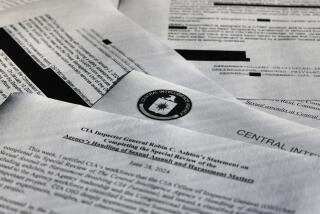A Frantic Call, a Fifth of Bourbon
- Share via
MOSCOW — In August 1990, an urgent message was delivered to a senior CIA official from Sergei Papushin, a former KGB major who had defected to the United States.
The Soviets have one of your people, Papushin warned. The CIA’s Moscow station has been penetrated by a KGB mole. And then a very strange thing happened to Sergei Papushin. He was found dead in a CIA apartment in Maryland, his body lying underneath his bed and an empty fifth of bourbon by his side.
The Papushin case--never publicly revealed until now--immediately set off alarm bells in the upper reaches of the CIA, where a top-secret investigation was already underway to determine why the CIA had suffered such grievous losses among its agents in Moscow.
At first, senior CIA officials believed Papushin’s message was the missing link: conclusive evidence that the CIA had been betrayed from within by a mole. “We took what Papushin had to say very seriously,” acknowledged a senior CIA official. Papushin’s mysterious death only added to the intrigue.
In hindsight, however, CIA officials are now convinced that Sergei Papushin was actually just a man who had made an outrageous guess that just happened to be uncomfortably close to the mark. He was, the CIA finally concluded, just a sad figure whose urgent message to the CIA’s brass was really a cry for help as he sat alone in a safe house, drowning himself in drink.
The mole the United States was looking for was actually found years later at CIA headquarters--Aldrich H. Ames--and the CIA now believes that Papushin didn’t really know anything about Ames and his espionage for the KGB.
Still, the defector’s story reveals much about the end game between the CIA and the KGB.
Papushin had been an officer in the KGB’s Second Chief Directorate, which handled counterintelligence inside the Soviet Union. His job had been to conduct surveillance of officers from MI-6, the British intelligence service.
Described by his former co-workers here as a brilliant but deeply flawed alcoholic whose father was a senior KGB official, Papushin quit the KGB in 1989 out of disgust with Moscow’s worsening political drift and the paralysis it was causing inside the KGB. At 34, he began a new life in the oil business in Moscow’s emerging private sector.
In November 1989, according to several U.S. and Russian sources, Papushin traveled to New York for his business, got drunk and had a run-in with the local police, who apparently brought him to the attention of the FBI. Briefly hospitalized in the New York area for an alcohol-related illness, Papushin was approached by the FBI.
Frightened, Papushin went to the Soviet mission in New York and told the security chief there that the FBI had made a pitch to him to defect, according to Sergei Totrov, a former Papushin colleague in the KGB’s Second Chief Directorate. Rather than bundling him onto a plane bound for Moscow, the apathetic security officer instead ignored the warning signs and told Papushin to forget about the incident and continue his business trip.
And so the next time someone traveling with his business delegation checked on him, Papushin had disappeared from his hotel. He had gone back to the FBI in New Jersey to defect.
By the time Papushin arrived on the FBI’s doorstep, the U.S. government was just starting to get more selective about which Soviets it accepted into its defector program. Within a year or so, so many ex-KGB officers were trying to jump off the sinking Soviet ship--nearly one a month--that the CIA had to start turning them away. Communism was in full retreat, and to many inside the KGB, the final collapse of the Soviet empire seemed inevitable.
Yet Papushin still represented a rare find for U.S. intelligence: a senior officer from one of the tough counterintelligence units of the Second Chief Directorate. CIA officials were eager to find someone from the KGB who could tell them why so many of their agents had been arrested and executed in Moscow, and they figured that a counterintelligence officer just might know.
At first, Papushin was able to provide plenty of information about KGB operations against MI-6, and so the CIA allowed British intelligence officers to help debrief him. But as time wore on, the CIA grew disappointed in Papushin as a source of knowledge on KGB operations against the CIA.
What was worse, he was drinking heavily. The CIA allowed him to write home to his wife, who had remained in Moscow with their daughter, but his letters were often so incoherent that it was clear they were written while he was drunk, recalls Totrov, who saw some of the letters. The CIA assigned at least two handlers to keep watch on him--mostly to protect him from himself. His CIA code name, “Decanter,” was unfortunately quite fitting.
Meanwhile, the KGB was scrambling to try to get him back. His father, Viktor Papushin, then the KGB’s station chief in Bulgaria, came to the United States to try to talk his son into coming home. His failure ended his KGB career, according to Totrov.
By August 1990, about nine months after he had defected and just as the CIA’s interest seemed to be on the wane, Papushin stunned his handlers. Deliver this message to the very top of the CIA, he asked them. When the written message warning of a mole arrived at CIA headquarters in Langley, Va., Papushin once again had the CIA leadership’s full attention.
Former KGB officers now say that Papushin could not possibly have known about Ames; information on that case was tightly held among a handful of very senior officers in the KGB’s First Directorate, which conducted foreign intelligence operations.
It is possible, however, that Papushin had heard rumors and snippets of conversations from his former KGB colleagues as they speculated about how their service had suddenly begun to uncover so many CIA spies and clandestine operations beginning in the mid-1980s.
“Papushin had close connections with officers in the First Branch of the Second Chief Directorate, so he may have heard things,” Totrov says. The first branch handled counterintelligence against the CIA in Moscow.
“He was very bright, and he was able to analyze facts and put things together well,” Totrov says. Papushin and other KGB counterintelligence officers may have simply guessed that the information on CIA agents in Russia was coming from a mole in the CIA’s Moscow station.
In fact, Ames had never served in Moscow, and so Papushin’s warning sent the CIA’s mole hunters looking in the wrong direction. It didn’t take long for senior CIA officials to realize that Papushin’s information didn’t check out, and it would be nearly four more years before they had enough evidence to arrest Ames.
But Papushin’s death was still a puzzle. Just hours before he died in February 1991, according to U.S. officials, his CIA handlers visited his apartment and saw nothing wrong with him. When they returned later in the day, they found his body underneath his bed, with the empty bottle beside him.
To make certain that he had not been murdered, the CIA ordered an autopsy, which proved that he had died of alcohol poisoning. Papushin had downed the entire fifth in about one hour.
Afterward, Papushin’s body was quietly flown back to Moscow for burial. Totrov, one of the only KGB officers to join Papushin’s wife at the funeral, was deeply distressed to see that his old comrade’s face was swollen beyond recognition. The only way he could identify Papushin was by a familiar scar on his hand.
“In the end, I think his death was convenient for everybody,” says Totrov bitterly. “He was no use to the CIA anymore, and the KGB certainly didn’t want him.
“It is a very sad story.”
(BEGIN TEXT OF INFOBOX / INFOGRAPHIC)
About This Series
Once it was the world’s most mysterious and feared espionage organization, the “sword and shield” of the Soviet Union. But ultimately the KGB fell victim to the same forces of history that destroyed the empire it had served.
For the most part, the last KGB officers slipped away, retaining the cloak of secrecy. But now a group of former officers have stepped forward to provide an insider’s guide. Their tales, with some details verifiable and others not, are of friendship and betrayal, of bravery and cowardice, of stunning triumphs and humiliating defeats.
They agreed to a series of interviews with the Los Angeles Times, in part to put on the record what they see as their sacrifices and professionalism in a cause now widely denigrated.
After the failed 1991 coup by a group of Communist hard-liners that included the KGB’s own chief, the Kremlin’s new leaders tore the KGB’s massive security apparatus apart. Hundreds, if not thousands, of KGB agents were laid off. In the process, many became pariahs, their dedication scorned, their work of covert operations stripped of respectability. By telling their stories now, they hope history will record a different view, one in which the KGB will be known for its successes as well as its stumbles.
* Today: The spy who directed Aldrich H. Ames.
* Tuesday: Two enemies, two friends.
* Wednesday: The Gavrilov channel, the KGB-CIA hotline.
More to Read
Sign up for Essential California
The most important California stories and recommendations in your inbox every morning.
You may occasionally receive promotional content from the Los Angeles Times.










